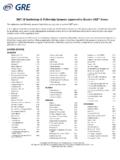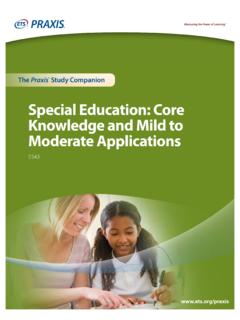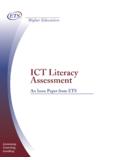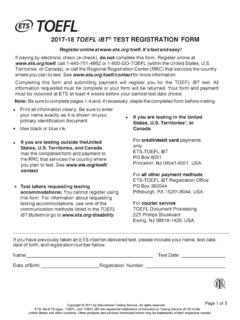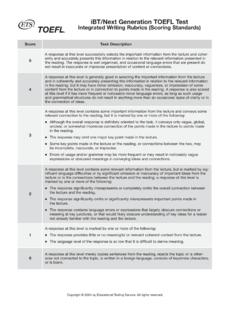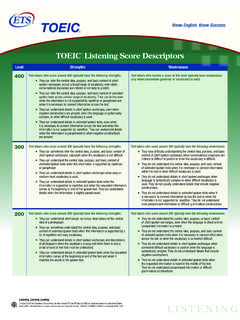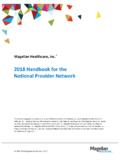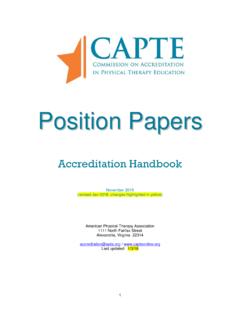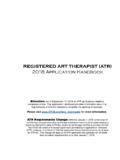Transcription of The PPAT Assessment Task 1 Handbook - ETS Home
1 The PPAT Assessment Task 1 Handbook From Student to Student Teacher: Transitioning from the Educator Preparation Program to the Clinical Experience Last Updated July 2020 Copyright 2020 by Educational Testing Service. All rights reserved. ETS, the ETS logo, MEASURING THE POWER OF LEARNING, and PPAT are registered trademarks of Educational Testing Service (ETS). All other trademarks are property of their respective owners. Table of Contents General Overview of the PPAT Assessment .. 4 PPAT Assessment Performance tasks .. 5 How This Handbook Can Help with Task 1 .. 5 The InTASC Model Core Teaching Standards .. 6 PPAT Assessment Rubrics and Exemplars .. 7 The Student Teacher .. 7 Guidance for Completing Task 1 .. 8 The Formative Focus of Task 1 .. 8 Additional Task 1 Benefits .. 9 Mentor Support for Task 1 .. 9 A Team Approach.
2 10 The EPP Instructor .. 10 The Cooperating Teacher .. 11 The Student Teacher .. 11 The Student Teacher (Ethical Considerations) .. 12 The Cooperating Teacher .. 13 How This Handbook Can Help with Task 1 .. 14 The EPP Instructor .. 15 The Role of Advance Preparation .. 16 Getting Started with Task 1 .. 17 What do I need to do to begin Task 1? .. 17 Build the Task in the My ETS Performance Assessment Home.. 18 Evaluation of Task 1 .. 18 Completing Task 1 Knowledge of Students .. 19 Overview .. 19 Task 1: Knowledge of Students and the Learning Environment .. 19 What Do I Have to Do for This Task? .. 19 How to Submit Your Evidence (Refer to the Submission System User Guide for details) .. 20 How to Compose Your Written Commentary .. 20 Task 1, Step 1 Overview .. 21 Rubric for Task 1, Step 1: Factors, Resources, and Protocols .. 25 The PPAT Assessment Task 1 Handbook 3 Task 1, Step 2 Overview.
3 30 Rubric for Task 1, Step 2 Knowledge of Students .. 35 Artifacts for Task 1, Step 1 .. 42 The Contextual Factors Chart .. 42 The Instructional and Support Resources Chart .. 42 Artifacts for Task 1, Step 2 .. 43 Getting to Know Your Students Activity .. 43 Communication with Your Students Families .. 44 PPAT Assessment Task 1 Submission List .. 45 Appendix A: Focused Reading Guide for Task 1 .. 47 TASK 1: Knowledge of Students and the Learning Environment .. 47 Step 1: Factors, Resources, and Protocols .. 47 Step 2: Knowledge of Students .. 48 The PPAT Assessment Task 1 Handbook 4 General Overview of the PPAT Assessment The PPAT a ssessment is an evidence-based performance Assessment designed to assess the instructional capability of pre-service teachers prior to receiving their teaching license. This Assessment evaluates teacher candidates on their ability to have an impact on student learning as stated in the InTASC Model Core Teaching Standards and the four PPAT Assessment tasks .
4 It is designed to: develop more effective teachers in the classroom identify strengths and areas for improvement of practice allow student teachers to continually refine their teaching practices contribute to a development plan for professional growth The Assessment consists of four tasks : one formative and three summative. The tasks are described in detail in the PPAT Assessment Candidate and Educator Handbook . Before beginning the Assessment , review that entire Handbook for information about the tasks , the rubrics, the writing guidelines, the Online Submission System, the video submission, and more. There are also other useful documents that will help support you through this process. Consult the PPAT Assessment informational website for additional information. You will be submitting your tasks in an online environment titled, My ETS Performance Assessment Home to which you will have access once you have registered.
5 Refer to the Submission System User Guide (PDF) for helpful information on navigating the system and entering your responses. This Handbook stresses only those aspects of the Assessment that are most relevant to complete the goals of Task 1. For complete information about the PPAT Assessment see: PPAT Assessment Candidate and Educator Handbook and the Submission System User Guide The PPAT Assessment Task 1 Handbook 5 PPAT Assessment Performance tasks The four tasks that the PPAT Assessment requires teacher candidates to complete during the student-teaching experience are not inconsequential: they represent authentic work that engages pre-service teachers in learning, planning, and reflecting activities that are focused on the assigned students and classroom. The tasks serve two purposes: (1) they provide a way for pre-service teachers to demonstrate their readiness for classroom teaching, and (2) they scaffold the teacher candidate s work during the student-teaching experience.
6 As all good classroom performance assessments do, the PPAT Assessment tasks both foster and measure learning. While all the PPAT Assessment tasks engage teacher candidates in relevant instructional activities, only one of the four is specifically intended to be a formative Assessment Task 1: Knowledge of Students and the Learning Environment. Task 1 is completed early in the clinical experience and is not scored as part of the pre-licensure requirement. However, it may be evaluated as part of the teacher candidate s EPP requirements. Task 1 must be submitted within the online system in order for the other tasks (2, 3, and 4) to become activated for the candidate. How This Handbook Can Help with Task 1 This Handbook provides guidance to help teacher candidates complete Task 1 of the PPAT Assessment . Task 1 activities are structured to encourage pre-service practitioners to draw on their educational preparation, their developing abilities, their peers, and all other resources available to them including the EPP instructor, the cooperating teacher, and this Handbook to complete this task formatively.
7 The PPAT Assessment Task 1 Handbook 6 The InTASC Model Core Teaching Standards The PPAT Assessment is aligned with the Interstate Teacher Assessment and Support Consortium (InTASC) Model Core Teaching Standards which are articulated across ten general areas of professional practice; and multiple performance indicators further elaborate on those areas. Throughout the careers of certified teachers, these standards serve as a focal point for professional dialogue. The teaching standards are referenced during professional development, are used to help individual teachers identify their professional strengths and areas for improvement and provide a basis for many teachers annual professional growth plans. Similarly, the close relationship between the PPAT Assessment and the InTASC Standards is intended to ensure that pre-service teachers perform at an acceptable level before they assume responsibilities as certified classroom teachers.
8 Teacher candidates are expected to be well versed in the standards and performance indicators, to engage with the standards and indicators when reflecting on their teaching and on their professional capabilities, and to understand what the standards mean in terms of day-to-day teaching and student learning. For this reason, the standards are referenced in this Handbook and within each of the four tasks of the PPAT Assessment as a focus for reflection and peer discussion. The specific standards for each PPAT Assessment task can help teacher candidates understand the expectations for their performance both on the Assessment and in the classroom. The standards can also help teacher candidates identify how well their draft performances address those expectations. See a complete version of the InTASC Standards. The PPAT Assessment Task 1 Handbook 7 PPAT Assessment Rubrics and Exemplars A tool that can help teacher candidates understand the state s expectations for their performance on the PPAT Assessment are the rubrics that accompany each task.
9 Each of the four PPAT Assessment tasks is broken into multiple steps, and a unique rubric is provided for each step. In addition to the rubrics, the Library of Examples provides a collection of written responses to the guiding prompts, which can help teacher candidates better understand the task before them. These examples can also be critical tools for helping teacher candidates visualize what a strong performance might look like in a particular context. You can access the Library of Examples on the PPAT Assessment informational website. The Student Teacher Because the PPAT Assessment tasks are closely aligned with key work that you do as a student teacher, reviewing the tasks and accompanying rubrics is another way you can prepare for the Assessment . 1. Read the overall description of Task 1. 2. Read the directions, forms, and guiding prompts for Task 1, Step 1.
10 3. Reflect on the rubric for Task 1, Step 1 4. Repeat steps 1-3 for Task 1 Step 2. As you review the rubrics for each Step, the following questions may help focus your reflections. What changes across the levels of this rubric? Why is this element important? Which teaching standards and indicators align with the rubric? Why are they important? How might each performance level for this Step impact a classroom and student learning? What are the connections between the guiding prompts and the rubrics? What are some ways you have learned to achieve positive effects associated with the rubric? The PPAT Assessment Task 1 Handbook 8 Guidance for Completing Task 1 This section of the Handbook is to help teacher candidates embrace the critical habits of mind associated with the teaching profession while completing Task 1 of the PPAT Assessment .
